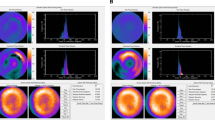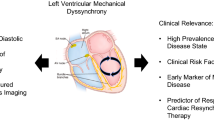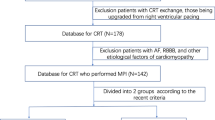Abstract
Purpose
We sought to evaluate the behavior of cardiac mechanical synchrony as measured by phase SD (PSD) derived from gated MPI SPECT (gSPECT) in patients with super-response after CRT and to evaluate the clinical and imaging characteristics associated with super-response.
Methods
158 subjects were evaluated with gSPECT before and 6 months after CRT. Patients with an improvement of LVEF > 15% and NYHA class I/II or reduction in LV end-systolic volume > 30% and NYHA class I/II were labeled as super-responders (SR).
Results
34 patients were classified as super-responders (22%) and had lower PSD (32° ± 17°) at 6 months after CRT compared to responders (45° ± 24°) and non-responders 46° ± 28° (P = .02 for both comparisons). Regression analysis identified predictors independently associated with super-response to CRT: absence of previous history of CAD (odds ratio 18.7; P = .002), absence of diabetes mellitus (odds ratio 13; P = .03), and history of hypertension (odds ratio .2; P = .01).
Conclusion
LV dyssynchrony after CRT implantation, but not at baseline, was significantly better among super-responders compared to non-super-responders. The absence of diabetes, absence of CAD, and history of hypertension were independently associated with super-response after CRT.


Similar content being viewed by others
Abbreviations
- gSPECT:
-
gated MPI SPECT
- PSD:
-
Phase standard deviation
- CRT:
-
Cardiac resynchronization therapy
- LBBB:
-
Left bundle branch block
- LVEF:
-
Left ventricular ejection fraction
- ESV:
-
End-systolic volume
- IAEA:
-
International atomic energy agency
- CAD:
-
Coronary artery disease
- NYHA:
-
New York Heart Association
References
Normand C, Linde C, Singh J, Dickstein K. Indications for cardiac resynchronization therapy: A comparison of the major international guidelines. JACC Hear Fail. 2018;6:308-16.
Ghani A, Delnoy PPHM, Adiyaman A, et al. Predictors and long-term outcome of super-responders to cardiac resynchronization therapy. Clin Cardiol. 2017;40:292-9.
Killu AM, Grupper A, Friedman PA, et al. Predictors and outcomes of “super-response” to cardiac resynchronization therapy. J Card Fail [Internet]. 2014;20:379-86. https://doi.org/10.1016/j.cardfail.2014.03.001.
Zecchin M, Proclemer A, Magnani S, et al. Long-term outcome of “super-responder” patients to cardiac resynchronization therapy. Europace. 2014;16:363-71.
Kydd AC, Khan FZ, Watson WD, Pugh PJ, Virdee MS, Dutka DP. Prognostic benefit of optimum left ventricular lead position in cardiac resynchronization therapy: Follow-up of the TARGET study cohort (targeted left ventricular lead placement to guide cardiac resynchronization therapy). JACC Hear Fail. 2014;2:205-12. https://doi.org/10.1016/j.jchf.2013.11.010.
Boogers MM, Van Kriekinge SD, Henneman MM, et al. Quantitative gated SPECT-derived phase analysis on gated myocardial perfusion SPECT detects left ventricular dyssynchrony and predicts response to cardiac resynchronization therapy. J Nucl Med. 2009;50:718-25.
Peix A, Karthikeyan G, Massardo T, et al. Value of intraventricular dyssynchrony assessment by gated-SPECT myocardial perfusion imaging in the management of heart failure patients undergoing cardiac resynchronization therapy (VISION-CRT). J Nucl Cardiol. 2019. https://doi.org/10.1007/s12350-018-01589-5.
Trucco E, Tolosana JM, Arbelo E, et al. Improvement of Reverse Remodeling Using Electrocardiogram Fusion-Optimized Intervals In Cardiac Resynchronization Therapy: A randomized study. JACC Clin Electrophysiol. 2018;4:181-9.
Kuznetsov VA, Soldatova AM, Kasprzak JD, Krinochkin DV, Melnikov NN. Echocardiographic markers of dyssynchrony as predictors of super-response to cardiac resynchronisation therapy—A pilot study. Cardiovasc Ultrasound. 2018;16:1-7.
Li K, Qian Z, Qian X, et al. Cardiac electrical and mechanical synchrony of super-responders to cardiac resynchronization therapy. Chin Med J. 2019;133:141-7.
Peix A, Mesquita CT, Paez D, et al. Nuclear medicine in the management of patients with heart failure: Guidance from an expert panel of the International Atomic Energy Agency (IAEA). Nucl Med Commun. 2014;35:818-23.
Hsu JC, Solomon SD, Bourgoun M, et al. Predictors of super-response to cardiac resynchronization therapy and associated improvement in clinical outcome: The MADIT-CRT (Multicenter Automatic Defibrillator Implantation Trial with Cardiac Resynchronization Therapy) study. J Am Coll Cardiol. 2012;59:2366-73. https://doi.org/10.1016/j.jacc.2012.01.065.
Manne M, Rickard J, Varma N, Chung MK, Tchou P. Normalization of left ventricular ejection fraction after cardiac resynchronization therapy also normalizes survival. Pacing Clin Electrophysiol. 2013;36:970-7. https://doi.org/10.1111/pace.12174.
Tan ESJ, Lim J, Chan SP, et al. Effect of diabetes mellitus on cardiac resynchronization therapy and to prognosis in heart failure (from the prospective evaluation of Asian with cardiac resynchronization therapy for heart failure study). Am J Cardiol. 2019;124:899-906. https://doi.org/10.1016/j.amjcard.2019.06.004.
Malik D, Mittal B, Sood A, Parmar M, Kaur G, Bahl A. Left ventricular mechanical dyssynchrony assessment in long-standing type II diabetes mellitus patients with normal gated SPECT-MPI. J Nucl Cardiol. 2018. https://doi.org/10.1007/s12350-018-1208-9.
Rohit MK, Krishnappa D. Incidence and predictors of super-response to cardiac resynchronization therapy. Indian Heart J. 2019;71:334-7. https://doi.org/10.1016/j.ihj.2019.09.007.
Vanderheyden M, Mullens W, Delrue L, et al. Myocardial gene expression in heart failure patients treated with cardiac resynchronization therapy: Responders versus nonresponders. J Am Coll Cardiol. 2008;51:129-36.
Proclemer A, Muser D, Facchin D. What we can learn from “super-responders”. Heart Fail Clin. 2017;13(1):225-32.
Chung ES, Leon AR, Tavazzi L, et al. Results of the predictors of response to crt (prospect) trial. Circulation. 2008;117(20):2608-16.
Bakos Z, Ostenfeld E, Markstad H, et al. A comparison between radial strain evaluation by speckle-tracking echocardiography and cardiac magnetic resonance imaging, for assessment of suitable segments for left ventricular lead placement in cardiac resynchronization therapy. Europace. 2014;16(12):1779-86.
Jin H, Gu M, Hua W, et al. Predictors of super-response to cardiac resynchronization therapy: The significance of heart failure medication, pre-implant left ventricular geometry and high percentage of biventricular pacing. J Geriatr Cardiol. 2017;14(12):737-42.
Theodorakis GN, Flevari P, Kroupis C, et al. Antiinflammatory effects of cardiac resynchronization therapy in patients with chronic heart failure. PACE Pacing Clin Electrophysiol. 2006;29(3):255-61.
de Souza Filho EM, Mesquita CT. Phase analysis of gated myocardial perfusion SPECT and cardiac resynchronization therapy: The good, the bad, and the ugly. J Nucl Cardiol. 2020. https://doi.org/10.1007/s12350-020-02056-w.
Jimenez-Heffernan A, Butt S, Mesquita CT, et al. Technical aspects of gated SPECT MPI assessment of left ventricular dyssynchrony used in the VISION-CRT study. J Nucl Cardiol. 2020. https://doi.org/10.1007/s12350-020-02122-3.
Henneman MM, Chen J, Dibbets-Schneider P, et al. Can LV dyssynchrony as assessed with phase analysis on gated myocardial perfusion SPECT predict response to CRT? J Nucl Med. 2007;48(7):1104-11.
Zafrir N. Left ventricular mechanical dyssynchrony graduation of myocardial perfusion gated SPECT phase analysis: What next. J Nucl Cardiol. 2018;25(3):1009-11.
Ioannidis JPA, Trikalinos TA, Danias PG. Electrocardiogram-gated single-photon emission computed tomography versus cardiac magnetic resonance imaging for the assessment of left ventricular volumes and ejection fraction: A meta-analysis. J Am Coll Cardiol. 2002;39:2059-68. https://doi.org/10.1016/S0735-1097(02)01882-X.
Patel C, Kalaivani M, Karthikeyan G, et al. Effect of cardiac resynchronization therapy on septal perfusion and septal thickening: Association with left ventricular function, reverse remodelling and dyssynchrony. J Nucl Cardiol. 2019. https://doi.org/10.1007/s12350-019-01704-0.
Marques de Souza Filho E, Tinoco Mesquita C, Altenburg Gismondi R, de Amorim Fernandes F, Jan Verberne H. Are there normal values of phase analysis parameters for left ventricular dyssynchrony in patients with no structural cardiomyopathy?: A systematic review. Nucl Med Commun. 2019;40:980-5.
Folks RD, Cooke CD, Garcia EV. Optimizing gated myocardial perfusion imaging processing for phase analysis. J Nucl Cardiol. 2016;23:1348-54.
Viveiros Monteiro A, Martins Oliveira M, Silva Cunha P, et al. Time to left ventricular reverse remodeling after cardiac resynchronization therapy: Better late than never. Rev Port Cardiol (English Ed) 2016;35:161-7. Available from: https://linkinghub.elsevier.com/retrieve/pii/S2174204916000520.
de Amorim Fernandes F, Peix A, Giubbini R, et al. Reproducibility of global LV function and dyssynchrony parameters derived from phase analysis of gated myocardial perfusion SPECT: A multicenter comparison with core laboratory setting. J Nucl Cardiol. 2020. https://doi.org/10.1007/s12350-020-02397-6.
Author information
Authors and Affiliations
Corresponding author
Additional information
Publisher's Note
Springer Nature remains neutral with regard to jurisdictional claims in published maps and institutional affiliations.
The authors of this article have provided a PowerPoint file, available for download at SpringerLink, which summarizes the contents of the paper and is free for re-use at meetings and presentations. Search for the article DOI on SpringerLink.com.
The authors have also provided an audio summary of the article, which is available to download as ESM, or to listen to via the JNC/ASNC Podcast.
Electronic supplementary material
Below is the link to the electronic supplementary material.
Rights and permissions
About this article
Cite this article
Mesquita, C.T., Peix, A., de Amorim Fernandes, F. et al. Clinical and gated SPECT MPI parameters associated with super-response to cardiac resynchronization therapy. J. Nucl. Cardiol. 29, 1166–1174 (2022). https://doi.org/10.1007/s12350-020-02414-8
Received:
Accepted:
Published:
Issue Date:
DOI: https://doi.org/10.1007/s12350-020-02414-8




